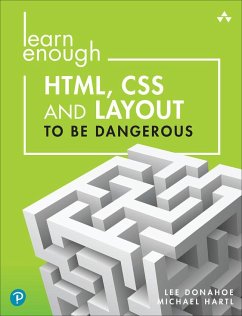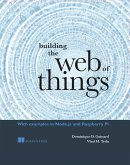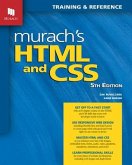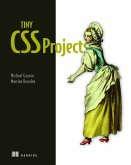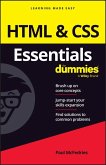Lee Donahoe, Michael Hartl
Learn Enough Html, CSS and Layout to Be Dangerous
An Introduction to Modern Website Creation and Templating Systems
Lee Donahoe, Michael Hartl
Learn Enough Html, CSS and Layout to Be Dangerous
An Introduction to Modern Website Creation and Templating Systems
- Broschiertes Buch
- Merkliste
- Auf die Merkliste
- Bewerten Bewerten
- Teilen
- Produkt teilen
- Produkterinnerung
- Produkterinnerung
"To design, build, and deploy modern websites, you need three core skills: the ability to write and edit HTML, wield CSS to control page design, and create efficient web layouts that serve users well. But you don't need to learn "everything" about HTML, CSS and web layout, just how to use them efficiently to solve real problems. In Learn Enough HTML, CSS and Layout to Be Dangerous, expert developer Lee Donahoe and renowned instructor Michael Hartl teach the specific concepts, skills, and approaches you need to get the job done. Even if you've never created a web page, the authors help you…mehr
Andere Kunden interessierten sich auch für
![Web Design with Html, Css, JavaScript and jQuery Set Web Design with Html, Css, JavaScript and jQuery Set]() Jon DuckettWeb Design with Html, Css, JavaScript and jQuery Set56,99 €
Jon DuckettWeb Design with Html, Css, JavaScript and jQuery Set56,99 €![Building the Web of Things Building the Web of Things]() Dominique GuinardBuilding the Web of Things34,99 €
Dominique GuinardBuilding the Web of Things34,99 €![Front-End Back-End Development with HTML, CSS, JavaScript, jQuery, PHP, and MySQL Front-End Back-End Development with HTML, CSS, JavaScript, jQuery, PHP, and MySQL]() Jon DuckettFront-End Back-End Development with HTML, CSS, JavaScript, jQuery, PHP, and MySQL79,99 €
Jon DuckettFront-End Back-End Development with HTML, CSS, JavaScript, jQuery, PHP, and MySQL79,99 €![Murach's HTML and CSS (5th Edition) Murach's HTML and CSS (5th Edition)]() Anne BoehmMurach's HTML and CSS (5th Edition)72,99 €
Anne BoehmMurach's HTML and CSS (5th Edition)72,99 €![Tiny CSS Projects Tiny CSS Projects]() Michael GearonTiny CSS Projects56,99 €
Michael GearonTiny CSS Projects56,99 €![HTML & CSS Essentials For Dummies HTML & CSS Essentials For Dummies]() Paul McFedriesHTML & CSS Essentials For Dummies12,99 €
Paul McFedriesHTML & CSS Essentials For Dummies12,99 €![Hugo in Action Hugo in Action]() Atishay JainHugo in Action56,99 €
Atishay JainHugo in Action56,99 €-
-
-
"To design, build, and deploy modern websites, you need three core skills: the ability to write and edit HTML, wield CSS to control page design, and create efficient web layouts that serve users well. But you don't need to learn "everything" about HTML, CSS and web layout, just how to use them efficiently to solve real problems. In Learn Enough HTML, CSS and Layout to Be Dangerous, expert developer Lee Donahoe and renowned instructor Michael Hartl teach the specific concepts, skills, and approaches you need to get the job done. Even if you've never created a web page, the authors help you quickly build technical sophistication and master the lore you need to succeed. Focused exercises help you internalize what matters, without wasting time on details pros don't care about. Soon, it'll be like you were born knowing this stuff--and you'll be suddenly, seriously dangerous"--
Produktdetails
- Produktdetails
- Verlag: Pearson Education (US)
- Seitenzahl: 688
- Erscheinungstermin: 27. August 2022
- Englisch
- Abmessung: 231mm x 180mm x 30mm
- Gewicht: 998g
- ISBN-13: 9780137843107
- ISBN-10: 0137843100
- Artikelnr.: 63117129
- Herstellerkennzeichnung
- Libri GmbH
- Europaallee 1
- 36244 Bad Hersfeld
- gpsr@libri.de
- Verlag: Pearson Education (US)
- Seitenzahl: 688
- Erscheinungstermin: 27. August 2022
- Englisch
- Abmessung: 231mm x 180mm x 30mm
- Gewicht: 998g
- ISBN-13: 9780137843107
- ISBN-10: 0137843100
- Artikelnr.: 63117129
- Herstellerkennzeichnung
- Libri GmbH
- Europaallee 1
- 36244 Bad Hersfeld
- gpsr@libri.de
Lee Donahoe is cofounder of Learn Enough and is an entrepreneur, designer, and front-end developer. At the age of 16 his late father handed him a tutorial on HTML, and for more than 25 years since then he has been creating things for the Web. In addition to doing the design and front-end development for Learn Enough, Softcover, and the Ruby on Rails Tutorial, he is also a cofounder and front-end developer for Coveralls, a leading test coverage analysis service, and is tech cofounder and front-end developer for Buck Mason, a Los Angeles based clothing company once featured on ABC's Shark Tank. Lee is a graduate of USC, where he studied economics as well as multimedia and creative technologies. Michael Hartl created the legendary Ruby on Rails Tutorial that helped jumpstart thousands of web development careers. A cofounder and principal author at Learn Enough, Hartl previously earned a Ph.D. in physics at the California Institute of Technology (Caltech), where he received a Lifetime Achievement Award for Excellence in Teaching. He is also an alumnus of Harvard University and the world-renowned Y Combinator entrepreneur program.
Preface xvii
About the Authors xxiii
Part I: Hypertext Markup Language 1
Chapter 1: Basic HTML 3
1.1 Introduction 6
1.2 HTML Tags 8
1.3 Starting the Project 12
1.4 The First Tag 17
1.5 An HTML Skeleton 20
Chapter 2: Filling in the Index Page 29
2.1 Headings 29
2.2 Text Formatting 31
2.3 Links 35
2.4 Adding Images 41
Chapter 3: More Pages, More Tags 51
3.1 An HTML Page About HTML 51
3.2 Tables 54
3.3 Divs and Spans 62
3.4 Lists 66
3.5 A Navigation Menu 68
Chapter 4: Inline Styling 73
4.1 Text Styling 74
4.2 Floats 79
4.3 Applying a Margin 82
4.4 More Margin Tricks 85
4.5 Box Styling 88
4.6 Navigation Styling 90
4.7 A Taste of CSS 93
4.8 Conclusion 98
Part II: Cascading Style Sheets and Page Layout 101
Chapter 5: Introduction to CSS 103
5.1 You're a Front-End Developer 106
5.2 CSS Overview and History 109
5.3 Sample Site Setup 116
5.4 Start Stylin' 121
5.5 CSS Selectors 128
Chapter 6: The Style of Style 133
6.1 Naming Things 134
6.2 When and Why 137
6.3 Priority and Specificity 140
6.4 How to Be a Good Styling Citizen 145
Chapter 7: CSS Values: Color and Sizing 157
7.1 CSS Color 157
7.2 Introduction to Sizing 163
7.3 Pixels (and Their Less-Used Cousin, the Point) 164
7.3.1 Exercise 168
7.4 Percentages 169
7.4.1 Percentage Fonts 174
7.4.2 Exercises 174
7.5 em 175
7.6 rem Isn't Just for Dreaming 181
7.7 vh, vw: The New(er) Kids on the Block 184
7.8 Just Make It Look Nice 190
Chapter 8: The Box Model 193
8.1 Inline vs. Block 193
8.2 Margins, Padding, and Borders 199
8.3 Floats 206
8.4 A Little More About the overflow Style 214
8.5 Inline Block 219
8.6 Margins for Boxes 223
8.7 Padding . . . Not Just for Chairs 234
8.8 Fun with Borders 235
Chapter 9: Laying It All Out 251
9.1 Layout Basics 251
9.2 Jekyll 253
9.3 Layouts, Includes, and Pages (Oh My!) 259
9.4 The Layout File 261
9.5 CSS File and Reset 264
9.6 Includes Intro: Head and Header 275
9.7 Advanced Selectors 284
9.8 Positioning 291
9.9 Fixed Header 309
9.10 A Footer, and Includes in Includes 312
Chapter 10: Page Templates and Frontmatter 327
10.1 Template Content 327
10.2 There's No Place Like Home 330
10.3 More Advanced Selectors 342
10.4 Other Pages, Other Folders 356
Chapter 11: Specialty Page Layouts with Flexbox 361
11.1 Having Content Fill a Container 363
11.2 Vertical Flex Centering 371
11.3 Flexbox Style Options and Shorthand 375
11.4 Three-Column Page Layout 381
11.5 A Gallery Stub 386
Chapter 12: Adding a Blog 397
12.1 Adding Blog Posts 398
12.2 Blog Index Content Loop 412
12.3 A Blog Post Page 419
Chapter 13: Mobile Media Queries 429
13.1 Getting Started with Mobile Designs 429
13.2 Mobile Adaptation 438
13.3 Mobile Viewport 449
13.4 Dropdown Menu 453
13.5 Mobile Dropdown Menu 463
Chapter 14: Adding More Little Touches 475
14.1 Custom Fonts 475
14.2 Favicons 488
14.3 Custom Title and Meta Description 490
14.4 Next Steps 497
Chapter 15: CSS Grid 499
15.1 CSS Grid at a High Level 501
15.2 A Simple Grid of Content 504
15.3 minmax, auto-fit, and auto-fill 515
15.4 Grid Lines, Areas, and Layouts 527
15.5 Grid on the Inside 556
15.6 Conclusion 589
Part III: Custom Domains 591
Chapter 16: A Name of Our Own 593
16.1 Custom Domain Registration 594
16.2 Cloudflare Setup 599
16.3 Custom Domains at GitHub Pages 606
Chapter 17: Custom Email 619
17.1 Google Mail 619
17.2 MX Records 622
17.3 Site Analytics 626
17.4 Conclusion 630
Index 635
About the Authors xxiii
Part I: Hypertext Markup Language 1
Chapter 1: Basic HTML 3
1.1 Introduction 6
1.2 HTML Tags 8
1.3 Starting the Project 12
1.4 The First Tag 17
1.5 An HTML Skeleton 20
Chapter 2: Filling in the Index Page 29
2.1 Headings 29
2.2 Text Formatting 31
2.3 Links 35
2.4 Adding Images 41
Chapter 3: More Pages, More Tags 51
3.1 An HTML Page About HTML 51
3.2 Tables 54
3.3 Divs and Spans 62
3.4 Lists 66
3.5 A Navigation Menu 68
Chapter 4: Inline Styling 73
4.1 Text Styling 74
4.2 Floats 79
4.3 Applying a Margin 82
4.4 More Margin Tricks 85
4.5 Box Styling 88
4.6 Navigation Styling 90
4.7 A Taste of CSS 93
4.8 Conclusion 98
Part II: Cascading Style Sheets and Page Layout 101
Chapter 5: Introduction to CSS 103
5.1 You're a Front-End Developer 106
5.2 CSS Overview and History 109
5.3 Sample Site Setup 116
5.4 Start Stylin' 121
5.5 CSS Selectors 128
Chapter 6: The Style of Style 133
6.1 Naming Things 134
6.2 When and Why 137
6.3 Priority and Specificity 140
6.4 How to Be a Good Styling Citizen 145
Chapter 7: CSS Values: Color and Sizing 157
7.1 CSS Color 157
7.2 Introduction to Sizing 163
7.3 Pixels (and Their Less-Used Cousin, the Point) 164
7.3.1 Exercise 168
7.4 Percentages 169
7.4.1 Percentage Fonts 174
7.4.2 Exercises 174
7.5 em 175
7.6 rem Isn't Just for Dreaming 181
7.7 vh, vw: The New(er) Kids on the Block 184
7.8 Just Make It Look Nice 190
Chapter 8: The Box Model 193
8.1 Inline vs. Block 193
8.2 Margins, Padding, and Borders 199
8.3 Floats 206
8.4 A Little More About the overflow Style 214
8.5 Inline Block 219
8.6 Margins for Boxes 223
8.7 Padding . . . Not Just for Chairs 234
8.8 Fun with Borders 235
Chapter 9: Laying It All Out 251
9.1 Layout Basics 251
9.2 Jekyll 253
9.3 Layouts, Includes, and Pages (Oh My!) 259
9.4 The Layout File 261
9.5 CSS File and Reset 264
9.6 Includes Intro: Head and Header 275
9.7 Advanced Selectors 284
9.8 Positioning 291
9.9 Fixed Header 309
9.10 A Footer, and Includes in Includes 312
Chapter 10: Page Templates and Frontmatter 327
10.1 Template Content 327
10.2 There's No Place Like Home 330
10.3 More Advanced Selectors 342
10.4 Other Pages, Other Folders 356
Chapter 11: Specialty Page Layouts with Flexbox 361
11.1 Having Content Fill a Container 363
11.2 Vertical Flex Centering 371
11.3 Flexbox Style Options and Shorthand 375
11.4 Three-Column Page Layout 381
11.5 A Gallery Stub 386
Chapter 12: Adding a Blog 397
12.1 Adding Blog Posts 398
12.2 Blog Index Content Loop 412
12.3 A Blog Post Page 419
Chapter 13: Mobile Media Queries 429
13.1 Getting Started with Mobile Designs 429
13.2 Mobile Adaptation 438
13.3 Mobile Viewport 449
13.4 Dropdown Menu 453
13.5 Mobile Dropdown Menu 463
Chapter 14: Adding More Little Touches 475
14.1 Custom Fonts 475
14.2 Favicons 488
14.3 Custom Title and Meta Description 490
14.4 Next Steps 497
Chapter 15: CSS Grid 499
15.1 CSS Grid at a High Level 501
15.2 A Simple Grid of Content 504
15.3 minmax, auto-fit, and auto-fill 515
15.4 Grid Lines, Areas, and Layouts 527
15.5 Grid on the Inside 556
15.6 Conclusion 589
Part III: Custom Domains 591
Chapter 16: A Name of Our Own 593
16.1 Custom Domain Registration 594
16.2 Cloudflare Setup 599
16.3 Custom Domains at GitHub Pages 606
Chapter 17: Custom Email 619
17.1 Google Mail 619
17.2 MX Records 622
17.3 Site Analytics 626
17.4 Conclusion 630
Index 635
Preface xvii
About the Authors xxiii
Part I: Hypertext Markup Language 1
Chapter 1: Basic HTML 3
1.1 Introduction 6
1.2 HTML Tags 8
1.3 Starting the Project 12
1.4 The First Tag 17
1.5 An HTML Skeleton 20
Chapter 2: Filling in the Index Page 29
2.1 Headings 29
2.2 Text Formatting 31
2.3 Links 35
2.4 Adding Images 41
Chapter 3: More Pages, More Tags 51
3.1 An HTML Page About HTML 51
3.2 Tables 54
3.3 Divs and Spans 62
3.4 Lists 66
3.5 A Navigation Menu 68
Chapter 4: Inline Styling 73
4.1 Text Styling 74
4.2 Floats 79
4.3 Applying a Margin 82
4.4 More Margin Tricks 85
4.5 Box Styling 88
4.6 Navigation Styling 90
4.7 A Taste of CSS 93
4.8 Conclusion 98
Part II: Cascading Style Sheets and Page Layout 101
Chapter 5: Introduction to CSS 103
5.1 You're a Front-End Developer 106
5.2 CSS Overview and History 109
5.3 Sample Site Setup 116
5.4 Start Stylin' 121
5.5 CSS Selectors 128
Chapter 6: The Style of Style 133
6.1 Naming Things 134
6.2 When and Why 137
6.3 Priority and Specificity 140
6.4 How to Be a Good Styling Citizen 145
Chapter 7: CSS Values: Color and Sizing 157
7.1 CSS Color 157
7.2 Introduction to Sizing 163
7.3 Pixels (and Their Less-Used Cousin, the Point) 164
7.3.1 Exercise 168
7.4 Percentages 169
7.4.1 Percentage Fonts 174
7.4.2 Exercises 174
7.5 em 175
7.6 rem Isn't Just for Dreaming 181
7.7 vh, vw: The New(er) Kids on the Block 184
7.8 Just Make It Look Nice 190
Chapter 8: The Box Model 193
8.1 Inline vs. Block 193
8.2 Margins, Padding, and Borders 199
8.3 Floats 206
8.4 A Little More About the overflow Style 214
8.5 Inline Block 219
8.6 Margins for Boxes 223
8.7 Padding . . . Not Just for Chairs 234
8.8 Fun with Borders 235
Chapter 9: Laying It All Out 251
9.1 Layout Basics 251
9.2 Jekyll 253
9.3 Layouts, Includes, and Pages (Oh My!) 259
9.4 The Layout File 261
9.5 CSS File and Reset 264
9.6 Includes Intro: Head and Header 275
9.7 Advanced Selectors 284
9.8 Positioning 291
9.9 Fixed Header 309
9.10 A Footer, and Includes in Includes 312
Chapter 10: Page Templates and Frontmatter 327
10.1 Template Content 327
10.2 There's No Place Like Home 330
10.3 More Advanced Selectors 342
10.4 Other Pages, Other Folders 356
Chapter 11: Specialty Page Layouts with Flexbox 361
11.1 Having Content Fill a Container 363
11.2 Vertical Flex Centering 371
11.3 Flexbox Style Options and Shorthand 375
11.4 Three-Column Page Layout 381
11.5 A Gallery Stub 386
Chapter 12: Adding a Blog 397
12.1 Adding Blog Posts 398
12.2 Blog Index Content Loop 412
12.3 A Blog Post Page 419
Chapter 13: Mobile Media Queries 429
13.1 Getting Started with Mobile Designs 429
13.2 Mobile Adaptation 438
13.3 Mobile Viewport 449
13.4 Dropdown Menu 453
13.5 Mobile Dropdown Menu 463
Chapter 14: Adding More Little Touches 475
14.1 Custom Fonts 475
14.2 Favicons 488
14.3 Custom Title and Meta Description 490
14.4 Next Steps 497
Chapter 15: CSS Grid 499
15.1 CSS Grid at a High Level 501
15.2 A Simple Grid of Content 504
15.3 minmax, auto-fit, and auto-fill 515
15.4 Grid Lines, Areas, and Layouts 527
15.5 Grid on the Inside 556
15.6 Conclusion 589
Part III: Custom Domains 591
Chapter 16: A Name of Our Own 593
16.1 Custom Domain Registration 594
16.2 Cloudflare Setup 599
16.3 Custom Domains at GitHub Pages 606
Chapter 17: Custom Email 619
17.1 Google Mail 619
17.2 MX Records 622
17.3 Site Analytics 626
17.4 Conclusion 630
Index 635
About the Authors xxiii
Part I: Hypertext Markup Language 1
Chapter 1: Basic HTML 3
1.1 Introduction 6
1.2 HTML Tags 8
1.3 Starting the Project 12
1.4 The First Tag 17
1.5 An HTML Skeleton 20
Chapter 2: Filling in the Index Page 29
2.1 Headings 29
2.2 Text Formatting 31
2.3 Links 35
2.4 Adding Images 41
Chapter 3: More Pages, More Tags 51
3.1 An HTML Page About HTML 51
3.2 Tables 54
3.3 Divs and Spans 62
3.4 Lists 66
3.5 A Navigation Menu 68
Chapter 4: Inline Styling 73
4.1 Text Styling 74
4.2 Floats 79
4.3 Applying a Margin 82
4.4 More Margin Tricks 85
4.5 Box Styling 88
4.6 Navigation Styling 90
4.7 A Taste of CSS 93
4.8 Conclusion 98
Part II: Cascading Style Sheets and Page Layout 101
Chapter 5: Introduction to CSS 103
5.1 You're a Front-End Developer 106
5.2 CSS Overview and History 109
5.3 Sample Site Setup 116
5.4 Start Stylin' 121
5.5 CSS Selectors 128
Chapter 6: The Style of Style 133
6.1 Naming Things 134
6.2 When and Why 137
6.3 Priority and Specificity 140
6.4 How to Be a Good Styling Citizen 145
Chapter 7: CSS Values: Color and Sizing 157
7.1 CSS Color 157
7.2 Introduction to Sizing 163
7.3 Pixels (and Their Less-Used Cousin, the Point) 164
7.3.1 Exercise 168
7.4 Percentages 169
7.4.1 Percentage Fonts 174
7.4.2 Exercises 174
7.5 em 175
7.6 rem Isn't Just for Dreaming 181
7.7 vh, vw: The New(er) Kids on the Block 184
7.8 Just Make It Look Nice 190
Chapter 8: The Box Model 193
8.1 Inline vs. Block 193
8.2 Margins, Padding, and Borders 199
8.3 Floats 206
8.4 A Little More About the overflow Style 214
8.5 Inline Block 219
8.6 Margins for Boxes 223
8.7 Padding . . . Not Just for Chairs 234
8.8 Fun with Borders 235
Chapter 9: Laying It All Out 251
9.1 Layout Basics 251
9.2 Jekyll 253
9.3 Layouts, Includes, and Pages (Oh My!) 259
9.4 The Layout File 261
9.5 CSS File and Reset 264
9.6 Includes Intro: Head and Header 275
9.7 Advanced Selectors 284
9.8 Positioning 291
9.9 Fixed Header 309
9.10 A Footer, and Includes in Includes 312
Chapter 10: Page Templates and Frontmatter 327
10.1 Template Content 327
10.2 There's No Place Like Home 330
10.3 More Advanced Selectors 342
10.4 Other Pages, Other Folders 356
Chapter 11: Specialty Page Layouts with Flexbox 361
11.1 Having Content Fill a Container 363
11.2 Vertical Flex Centering 371
11.3 Flexbox Style Options and Shorthand 375
11.4 Three-Column Page Layout 381
11.5 A Gallery Stub 386
Chapter 12: Adding a Blog 397
12.1 Adding Blog Posts 398
12.2 Blog Index Content Loop 412
12.3 A Blog Post Page 419
Chapter 13: Mobile Media Queries 429
13.1 Getting Started with Mobile Designs 429
13.2 Mobile Adaptation 438
13.3 Mobile Viewport 449
13.4 Dropdown Menu 453
13.5 Mobile Dropdown Menu 463
Chapter 14: Adding More Little Touches 475
14.1 Custom Fonts 475
14.2 Favicons 488
14.3 Custom Title and Meta Description 490
14.4 Next Steps 497
Chapter 15: CSS Grid 499
15.1 CSS Grid at a High Level 501
15.2 A Simple Grid of Content 504
15.3 minmax, auto-fit, and auto-fill 515
15.4 Grid Lines, Areas, and Layouts 527
15.5 Grid on the Inside 556
15.6 Conclusion 589
Part III: Custom Domains 591
Chapter 16: A Name of Our Own 593
16.1 Custom Domain Registration 594
16.2 Cloudflare Setup 599
16.3 Custom Domains at GitHub Pages 606
Chapter 17: Custom Email 619
17.1 Google Mail 619
17.2 MX Records 622
17.3 Site Analytics 626
17.4 Conclusion 630
Index 635

